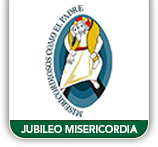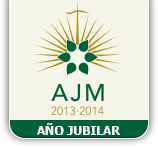Our Lady of Esperanza
 The first paso de palio (canopied paso) of La Virgen de La Esperanza was probably relatively modest, but between 1689 and 1690 it was replaced by another with silver poles, a suitably embroidered black velvet canopy and a silver base made by Francisco de Godoy. This paso was one of the most luxurious to be seen in Seville. In 1841 its silver poles were removed and substituted by wooden ones with gilded knot adornments. In 1881 a very original straight edged canopy was made at the Ysaura workshops. It had elegant rolled silver cornices and openwork bambalinas (side-hangings) contoured with leaf garlands chased also in rolled silver.
The first paso de palio (canopied paso) of La Virgen de La Esperanza was probably relatively modest, but between 1689 and 1690 it was replaced by another with silver poles, a suitably embroidered black velvet canopy and a silver base made by Francisco de Godoy. This paso was one of the most luxurious to be seen in Seville. In 1841 its silver poles were removed and substituted by wooden ones with gilded knot adornments. In 1881 a very original straight edged canopy was made at the Ysaura workshops. It had elegant rolled silver cornices and openwork bambalinas (side-hangings) contoured with leaf garlands chased also in rolled silver.In 1900 Josefa Rodríguez Ojeda made a new, gold-embroidered black canopy based on a design by her brother Juan Manuel, and in 1901 she added side skirts and respiraderos. New poles were also incorporated, made by Baldomero López from drawings by Juan Manuel Rodríguez Ojeda. The front and rear candelabra and the llamador (knocker) made their first appearance in 1905.
In 1907 a silver candelabra array and a new canopy were commissioned. On Good Friday, 1913, the sterling gold crown designed by Juan Manuel Rodríguez Ojeda as an offering by the Brotherhood to La Virgen de La Esperanza was solemnly blessed by Cardinal Enrique Almaraz and placed on the Virgin’s head by Juan Francisco Muñoz y Pabón, Prebendary Canon at Seville Cathedral. In 1915 Juan Manuel Rodríguez Ojeda made some new maroon velvet skirts, and the following year Manuel Seco Imberg produced the rear candelabra, which would be destroyed in 1936. In 1930, Juan Manuel made a new canopy.
Between 1935 and 1936 a set of new sterling silver poles was executed based on a Renaissance style design by Cayetano González Gómez. The designer made the first four himself, the others being crafted by his students: Francisco Bautista, Emilio Landa and Juan Fernández. In 1941the Sobrinos de Caro embroidery shop started work on enhancing and enriching the canopy, respiraderos and side skirts of the paso. In 1964 the side hangings of the canopy were replaced with ones embroidered in fine gold thread on gold netting, but bearing the same design as the earlier canopy. Again, the work was done at the Sobrinos de Caro workshop. The new respiraderos were embroidered in gold on netting by Esperanza Elena Caro in 1967, following in the same style as the earlier ones.
 The earliest recorded embroidered processional mantle made its first public appearance in 1828. Its creator is not known. Another mantle was made in green velvet in 1863, and yet another green velvet mantle was designed by Juan Manuel Rodríguez Ojeda, embroidered by Elisa Rivera and displayed in public for the first time 1881. At this time Rodríguez Ojeda was still influenced by the aesthetic tastes typical of the period, and his creation featured large format designs made up of rising, curling thistle leaves interwoven with long winding stems topped by smaller leaves.
The earliest recorded embroidered processional mantle made its first public appearance in 1828. Its creator is not known. Another mantle was made in green velvet in 1863, and yet another green velvet mantle was designed by Juan Manuel Rodríguez Ojeda, embroidered by Elisa Rivera and displayed in public for the first time 1881. At this time Rodríguez Ojeda was still influenced by the aesthetic tastes typical of the period, and his creation featured large format designs made up of rising, curling thistle leaves interwoven with long winding stems topped by smaller leaves.
This mantle was later sold to La Hermandad de Los Gitanos. The Madrugada (early morning) procession on Good Friday, 1900, saw the debut of another green velvet mantle embroidered in gold and coloured silk on gold netting. This one, also designed by Juan Manuel Rodríguez Ojeda, caused a furore for the sheer originality of its netting, or gauze, design, and indeed came to be known as the “gauze mantle”.
In 1930 La Virgen de la Esperanza appeared for the first time dressed in a new green lamé mantle made, like the others, in the Rodríguez Ojeda workshop. Finally, a new green velvet mantle was embroidered to mark the occasion of the Canonical Coronation of La Virgin de La Esperanza. This one was made by Esperanza Elena Caro from a design by Fernando Marmolejo Camargo.
| Previous | Return | Up | Next |






